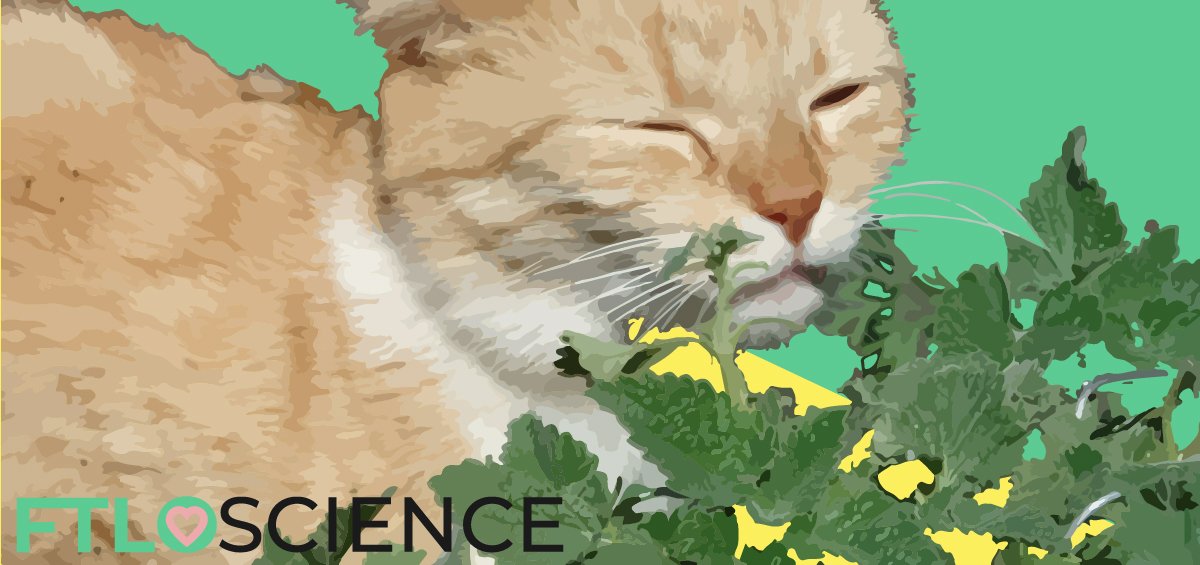If you didn’t already know, cats love catnip (also known as catmint)! The mere smell of the plant drives many felines into a state of euphoria, strangely eliciting the same sequence of playful behavior. The catnip response highlights a unique relationship between plant and animal, likely driven by mere coincidence rather than evolution. What chemical compounds are responsible for driving cats into this controlled frenzy? We explore the chemistry of cats and catnip.
The Catnip Response
The catnip (Nepeta cataria) is a species of plant that is found throughout the world, known for its immense appeal toward felines, especially domesticated cats. Usually sold in the form of dry leaves, catnip can also be stuffed into toys, sprayed as a mist or even infused in ‘wine’ for cats! Catnip is also effective as a relaxant in humans, often in herbal tea concoctions.

Behavioral Changes
Not all cats are susceptible to the charms of catnip, but when they do, their responses are similar. Studies have classified the standard ‘catnip response’ into 4 distinct actions: sniffing the catnip, licking/chewing it with head shaking, chin and cheek rubbing, head-over rolling and body rubbing1.
This response period typically lasts for 5 to 15 minutes, after which the catnip doesn’t seem to affect the animal for at least an hour. Cats that consume excess catnip may exhibit behaviors ranging from drooling and sleepiness to anxiety and hyperactivity. These short-term effects are generally safe, which has led to cat owners providing catnip as a ‘recreational’ substance for their pets.
Catnip Doesn’t Affect All Cats
It has also been shown that big cats like leopards, cougars and lynxes respond to catnip, although the effect is less common in tigers and lions. In domestic cats, about two-thirds of the population is susceptible to these strange catnip-induced behavioral changes.
The catnip response is thought to be hereditary, as felines that exhibit the response are more likely to have offspring that also respond to catnip. However, the trait is not controlled by a single gene and likely involves contributions from several different genes.
A cat’s quality of life is enriched by so-called ‘olfactory enrichment’, as they are animals with a highly developed sense of smell. A study of 100 cats showed that many that didn’t respond to catnip were instead stimulated by silver vine fruit galls2. Other plants that elicit similar responses include the Tatarian honeysuckle and valerian root.
Delving into Catnip Chemistry
Nepetalactone – The Active Ingredient in Catnip
The active chemicals or ‘essential oils’ in catnip can be isolated by simple steam distillation. The main ingredient is a chemical called nepetalactone, directly responsible for the catnip response. This was confirmed in 1942 when a group of researchers showed that adult lions reacted to pure nepetalactone just as they did the whole catnip plant. Cats were unavailable in their location, presumably.

Nepetalactone and its derivatives are produced by plants, which use these chemicals for signaling and defense. Its primary effect is as an insect repellent, providing the plant protection against hungry ants and beetles. Nepetalactone is also a mosquito repellent, although it isn’t as effective as commercial repellents when sprayed onto our skin.

More Than a Psychological ‘Trip’ for Cats
It’s not known why such plant pheromones have such a pronounced effect on cats, while other mammals remain relatively unaffected by catnip. Nepetalactone and its related molecules interact with a cat’s complex sense of smell, also known as its olfactory system. The primary organ in this system is the olfactory bulb, responsible for sending ‘smell signals’ to the brain. Removing the olfactory bulb in cats removes the catnip effect entirely4.
The catnip response is often thought to be a psychological ‘trip’ for cats, setting off neurotransmitters in their brains that provide feelings of pleasure. However, there is evidence that the response also triggers more complex behaviors.
The rubbing and rolling involved in the catnip reaction suggest that nepetalactone triggers parts of the cats’ brains responsible for mediating sexual behavior. In addition, sniffing and chewing of the catnip is associated with oral appetitive behavior, while a certain kicking is linked with predatory behavior. Clearly, there’s a lot to be learnt about how and why cats respond to catnip!
Reference
- Tucker, A. O., & Tucker, S. S. (1988). Catnip and the catnip response. Economic Botany, 42(2), 214-231.
- Bol, S., Caspers, J., Buckingham, L., Anderson-Shelton, G. D., Ridgway, C., Buffington, C. T., … & Bunnik, E. M. (2017). Responsiveness of cats (Felidae) to silver vine (Actinidia polygama), Tatarian honeysuckle (Lonicera tatarica), valerian (Valeriana officinalis) and catnip (Nepeta cataria). BMC Veterinary Research, 13(1), 70.
- Eisner, T. (1964). Catnip: its raison d’etre. Science, 146(3649), 1318-1320.
- Hart, B. L., & Leedy, M. G. (1985). Analysis of the catnip reaction: mediation by olfactory system, not vomeronasal organ. Behavioral and Neural Biology, 44(1), 38-46.
About the Author

Sean is a consultant for clients in the pharmaceutical industry and is an associate lecturer at La Trobe University, where unfortunate undergrads are subject to his ramblings on chemistry and pharmacology.




